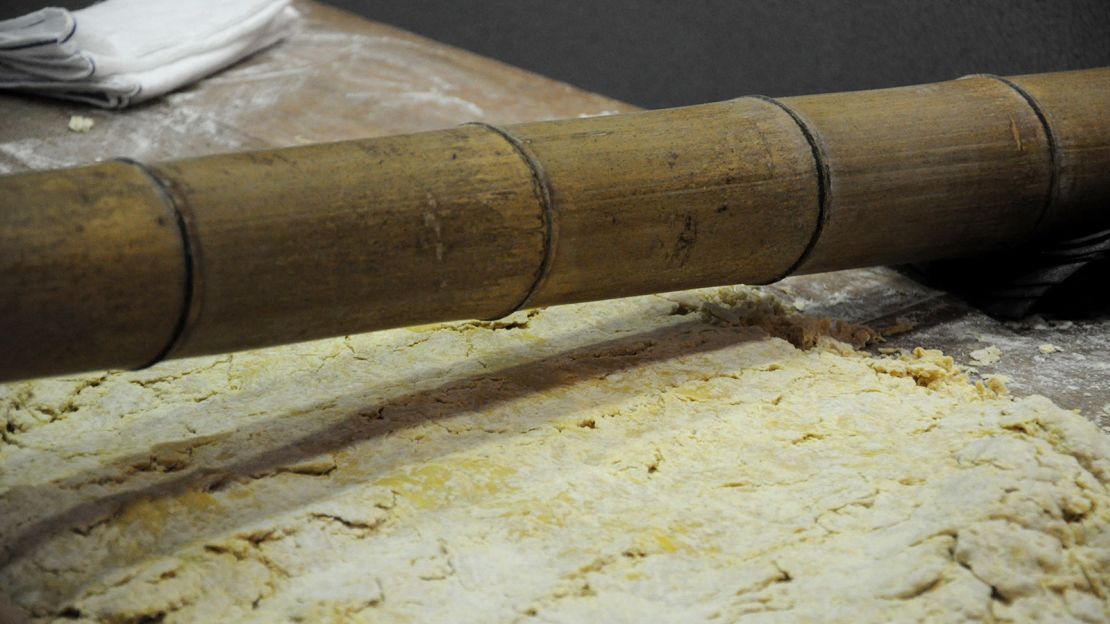Editor’s Note: CNN Travel’s series often carries sponsorship originating from the countries and regions we profile. However, CNN retains full editorial control over all of its reports. Read the policy.
Almost as if he’s climbing onto a seesaw, Hong Kong noodle master Ken Lee straddles the long bamboo pole that’s hanging off the end of a heavy wooden table.
The opposite end of the bamboo is hooked into a gigantic rubber band that’s chained to the wall. On the table lies a fresh pile of dough, which will soon be kneaded by the bamboo as Lee bounces up and down, his feet planted on a low bench.
It’s all part of the process required to make jook-sing noodles, an increasingly rare food here.
Only a handful of noodle masters know the skill.
“There are around 10 jook-sing noodle masters left in Hong Kong nowadays,” says Fei Wong, the third-generation owner of Wong Chi Kei.
Originally founded in Macau in 1946, it’s one of the most popular noodle joints in Hong Kong. It’s also one of the few remaining noodle shops to produce its own jook-sing noodles. Among its three outlets in Hong Kong and Macau, Wong Chi Kei sells close to 2,000 bowls of noodles per day.
What makes jook-sing noodles so special?
Jook-sing noodles, or bamboo pole noodles, originated in China’s Canton region.
They’re also a key – yet often overshadowed – component of wonton noodles, one of Hong Kong’s most iconic dishes.
“Jook-sing noodles are made with eggs, flour and a little bit of alkaline water,” says noodle master Lee, Wong Chi Kei’s executive chef and Wong’s cousin.
Bamboo noodles: A dying culinary tradition
“What makes them special is the usage of the bamboo stick. By beating the dough this way, the dough will develop gluten that creates a refreshing, al dente texture in the noodles,” says Lee, who has been making the noodles for more than two decades.
All of Wong Chi Kei’s noodles are now crafted in Macau, but a noodle room is reserved in Hong Kong’s Causeway Bay branch for occasional workshops and performances.
Today, says Lee, most of the noodles you’ll find in Hong Kong’s markets are made solely by machines and don’t go through the bamboo-kneading process.
“They rely on adding a lot of alkaline water to make the noodles al dente, which reeks in the noodles,” he adds.
“We use our hands and bamboo poles to make the noodles. You can tell the difference between the two.”
Why bamboo? The highly versatile plant is prized for its flexibility and durability. This makes it the perfect instrument to impart the huge amount of force required to execute the kneading.
The current pole in the Causeway Bay Wong Chi Kei shop has been used for more than a decade. The wooden table is specially designed and nailed to the floor. Undergoing years of bamboo-beating, it has a slight depression on its surface.
Just keep bouncing
“The biggest challenge in keeping the traditional handcraft alive is the lack of talent in the market,” says Wong.
“The monotonous and physically demanding job nature has deterred many youngsters from joining the industry, the Chinese culinary industry in general.
“My uncle, who is a bridge engineer, has been looking into the physics and mechanics of jook-sing noodles so hopefully, we can create a formula for a machine that can mimic the traditional bamboo-beating.”
But there are still things that machines can’t replace. Lee pauses his bouncing and feels the dough.
“You have to feel it yourself,” he says. “If the dough isn’t good enough, we need to keep bouncing on it until it’s ready.”
He folds the flattened dough, returns to his original position and starts bouncing on the bamboo pole again.
“The more you practice, the more you’ll know how to make the noodle, depending on the humidity and the weather. Nobody can teach you this – you have to learn and understand this yourself. It took me about six to seven years to master the skill.”
Weight is an advantage in the traditional craft.
“You need to use less energy if you’re heavier,” says Wong. “But my grandfather (the founder) weighed only 120 pounds. When he was on the bamboo, he needed to leap really high on one foot. It looked like he was doing kung fu.”

When ready, the dough will be fed into a machine to be further flattened and cut into thin noodles. As a teenager, Wong spent his summer learning how to make jook-sing noodles – a family tradition.
“I performed, making jook-sing noodles in the Causeway Bay branch when I first returned to the family business,” says Wong.
“It soon gave me a sore bum – I had been out of practice.”
Continuing the legacy
Wong, who helms the company’s business development department, often looks for ways to modernize the company.
For instance, Wong Chi Kei has started selling dried jook-sing noodles, dubbed Yea Yea Noodles (or translated as Grandpa Noodles), as souvenirs and gifts in recent years. It’s hoped that the modern design will attract and expand jook-sing noodles’ clientele.
“Wong Chi Kei has fed three generations of people – it means a lot to me,” says Wong.
“My grandfather had spent decades perfecting the noodles. I want to continue his legacy and keep on improving the noodles. In Japan, there are family businesses that last for as long as eight generations – that’s 300 years of history.
“It’s a challenge to develop a business that lasts for generations but if we can build a history like that, it’ll become a valuable heritage for the food and beverage industry.”
Wong Chi Kei, Way On Commercial Building, 500 Jaffe Road, Causeway Bay; Open daily 11 a.m.-10:30 p.m.




























